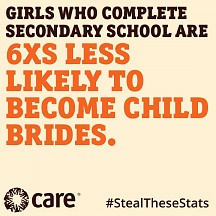Education Before Marriage: Give Girls a Fighting Chance
Mar 8th, 2018 | By admin | Category: Youth RightsBy Suzanne York.
As the world recognizes International Women’s Day this March 8th, there is no shortage of important issues affecting women that should be brought to the table. As movements such as #MeToo and #TimesUp have brought little discussed problems to the forefront, there is reason, at long last, to feel hope that “society” is moving in the right direction.Marriage? Or School?
One long-entrenched problem affecting women and girls that seems to be getting better is that of child marriage. According to a recent report by UNICEF, child marriages are on the decline. In South Asia, the rate of child marriage has dropped from 50 percent to 30 percent. This is certainly something to celebrate. Yet despite the decline, UNICEF stated that 12 million girls are married in childhood every year.
While child brides in South Asia may be declining, in Sub-Saharan Africa, where most of the world’s population growth will occur in the next few decades, the rate is sadly increasing. One in three recently married child brides are now in sub-Saharan Africa, compared to one in five a decade ago.
Mabel van Oranje, Chair of Girls Not Brides, an advocacy organization, emphasized being on guard, saying “However, we must not become complacent. There is still a long way to go. It is unacceptable that 12 million girls are still being married off each year before age 18. Until each one of those girls has the opportunity to choose who, when and whether she marries, we must redouble our efforts to end child marriage.”
Girls who marry young face complications during pregnancy, drop out of school or aren’t allowed to go to school, have limited economic opportunities, have higher rates of maternal mortality, and face a greater chance of gender-based violence.
Ending child marriage is a target under the global Sustainable Development Goals, which are committed to ending the practice by 2030. However, Girls Not Brides states that if progress is not accelerated, 150 million girls will marry as children between now and then.
Child marriage cuts across all boundaries, be it country, culture, religion, or ethnicity. Even the U.S. is not immune.
Climate change – A Driver of Child Marriage
This International Women’s Day, it is important to understand the links between weak and/or declining rights for women and girls and climate change impacts. Women often bear the brunt of severe climate change, and child marriage is perhaps increasingly given as a solution to help families cope with climate-driven problems such as loss of crops from droughts or floods.
In Malawi, one of the world’s poorest nations, there are 1.5 million girls who are now at risk of getting married before adulthood because of climate change. Brides of the Sun, an independent investigative project, found that in villages around Malawi and also Mozambique, extreme weather was leading more families to struggle to afford to feed and house their own children. Entrenched poverty was a driving force of child marriage. When crops and livestock are wiped out or fisheries decline, girls are often considered a burden and a family’s one expendable option, especially if a dowry is paid for the girl.
Ending child marriage and early child-bearing could reduce fertility and lower population growth by about one tenth in high prevalence countries.
Child Marriage-free Zones
An intriguing way to change and end the practice of girls marrying too young is creating “child marriage-free zones” where girls stand together and refuse to be married. Bangladesh has been a pioneer in this movement, with the Wedding Busters project run by Plan International that works with local government and community-based organizations to create child marriage-free zones to stop early marriage.
ActionAid has supported a project in which many villages in Nepal are being declared ‘child marriage-free zones’. Elsewhere in Nepal, Sakarpura was just declared a child marriage-free zone. In India, the entire village of Husangsar has taken an oath to make their community a child marriage-free zone.
Pakistan, too, has such a zone, in Matiari, Sindh province. Some of the activities in this Pakistani child marriage-free zone include:
- Setting up youth groups to campaign against child marriages and facilitate interventions;
- Training marriage registrars on how to deal with underage marriages and fill in marriage certificates correctly, and teaching them more about local laws;
- Creating a knowledge and portal hub for up-to-date news, research and tools on child marriages.
In Uganda, according to the World Bank, approximately 1,500 girls clubs in the country offer games, music, sex education, financial literacy, vocational training, and access to microfinance for young women trying to become entrepreneurs. Girls who have been members of the clubs for two years are 58 percent less likely to marry early.
![[photo: UNICEF/UN0119446/Brown]](http://populationgrowth.org/wp-content/uploads/2018/03/Malawi-teacher-1024x712.jpg)
[photo: UNICEF/UN0119446/Brown] In Malawi, primary school teacher Esther and her student Sophilat stand outside their classroom at the end of a life skills lesson. The school is supported by the UN Joint Programme on Girls Education. Esther helps identify children at risk of dropping out school and persuades their parents of the benefits of keeping them in school.
It Begins with an “E” – Empowerment, Education, Equity & Equality
In order to affect real change, empowering girls and women is crucial. And education for girls – and also boys – is key. One would hope that ending child marriage is an issue that cuts across differences and brings us together in support of young women who deserve a strong and fair start in a challenging world. Some 12 million girls right now are hoping for a chance for a brighter future.
Suzanne York is Director of Transition Earth.

![[photo: UNICEF/UN062031/Vishwanathan]](http://populationgrowth.org/wp-content/uploads/2018/03/UN062031-300x200.jpg)
